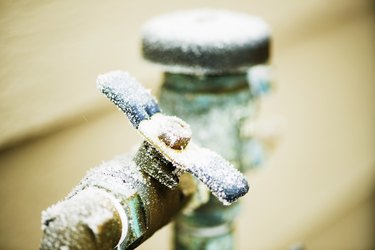Tips for Avoiding Frozen Plumbing in Cold Weather: Specialist Insights
Prices & BookingWe have stumbled upon the article involving Prevent Frozen Pipes down the page on the web and reckoned it made sense to share it with you on this page.

Cold weather can ruin your plumbing, particularly by freezing pipelines. Right here's exactly how to prevent it from occurring and what to do if it does.
Introduction
As temperature levels decrease, the risk of icy pipes increases, potentially bring about costly repairs and water damages. Comprehending how to prevent icy pipes is vital for house owners in cold climates.
Comprehending Icy Pipes
What triggers pipelines to ice up?
Pipes freeze when exposed to temperatures listed below 32 ° F (0 ° C) for prolonged periods. As water inside the pipes freezes, it increases, taxing the pipe walls and possibly creating them to break.
Threats and problems
Icy pipelines can bring about water system disturbances, home damage, and costly repair work. Burst pipelines can flooding homes and create substantial structural damages.
Indicators of Frozen Pipeline
Recognizing icy pipes early can stop them from bursting.
Just how to recognize frozen pipelines
Look for decreased water flow from taps, unusual smells or noises from pipes, and visible frost on subjected pipelines.
Avoidance Tips
Shielding susceptible pipes
Wrap pipelines in insulation sleeves or use heat tape to protect them from freezing temperatures. Focus on pipes in unheated or external locations of the home.
Home heating techniques
Maintain indoor areas appropriately warmed, particularly areas with plumbing. Open closet doors to allow warm air to circulate around pipelines under sinks.
Securing Exterior Pipes
Garden hoses and exterior taps
Detach and drain yard hose pipes before wintertime. Set up frost-proof faucets or cover outdoor taps with protected caps.
What to Do If Your Pipelines Freeze
Immediate actions to take
If you presume icy pipes, maintain taps open to alleviate pressure as the ice melts. Utilize a hairdryer or towels soaked in warm water to thaw pipelines gradually.
Long-Term Solutions
Structural modifications
Take into consideration rerouting pipes away from outside wall surfaces or unheated locations. Add additional insulation to attics, basements, and crawl spaces.
Upgrading insulation
Purchase high-grade insulation for pipelines, attic rooms, and walls. Proper insulation helps preserve consistent temperatures and decreases the risk of icy pipes.
Verdict
Stopping frozen pipes needs aggressive procedures and quick feedbacks. By recognizing the reasons, indications, and safety nets, house owners can safeguard their pipes throughout winter.
Helpful Tips to Prevent Frozen Pipes this Winter
UNDERSTANDING THE BASICS: WHY PIPES FREEZE AND WHY IT’S A PROBLEM
Water freezing inside pipes is common during the winter months, but understanding why pipes freeze, and the potential problems it can cause is crucial in preventing such incidents. This section will delve into the basics of why pipes freeze and the associated problems that may arise.
THE SCIENCE BEHIND FROZEN PIPES
When water reaches freezing temperatures, it undergoes a physical transformation and solidifies into ice. This expansion of water as it freezes is the primary reason pipes can burst. As the water inside the pipe freezes, it expands, creating immense pressure on the walls. If the pressure becomes too great, the pipe can crack or rupture, leading to leaks and water damage.
FACTORS THAT CONTRIBUTE TO PIPE FREEZING
Low Temperatures: Extremely cold weather, especially below freezing, increases the risk of pipes freezing. Uninsulated or Poorly Insulated Pipes: Pipes located in unheated areas, such as basements, crawl spaces, or attics, are more prone to freezing. Insufficient insulation or lack of insulation altogether exacerbates the problem. Exterior Wall Exposure: Pipes running along exterior walls are susceptible to freezing as they encounter colder temperatures outside. Lack of Heating or Temperature Regulation: Inadequate heating or inconsistent temperature control in your home can contribute to frozen pipes. PROBLEMS CAUSED BY FROZEN PIPES
- Pipe Bursting: As mentioned earlier, the expansion of water as it freezes can cause pipes to burst, resulting in significant water damage.
- Water Damage: When pipes burst, it can lead to flooding and water damage to your property, including walls, ceilings, flooring, and personal belongings.
- Structural Damage: Prolonged exposure to water from burst pipes can compromise the structural integrity of your home, leading to costly repairs.
- Mold and Mildew Growth: Excess moisture from water damage can create a favorable environment for mold and mildew growth, posing health risks to occupants.
- Disrupted Water Supply: Frozen pipes can also result in a complete or partial loss of water supply until the issue is resolved.
WHY CERTAIN PIPES ARE MORE PRONE TO FREEZING
- Location: Pipes located in unheated or poorly insulated areas, such as basements, crawl spaces, attics, or exterior walls, are at higher risk of freezing.
- Exterior Pipes: Outdoor pipes, such as those used for irrigation or exposed plumbing, are particularly vulnerable to freezing as they are directly exposed to the elements.
- Supply Lines: Pipes that carry water from the main water supply into your home, including the main water line, are critical to protect as freezing in these lines can affect your entire plumbing system.
- Underground Pipes: Pipes buried underground, such as those connected to sprinkler systems or outdoor faucets, can be susceptible to freezing if not properly insulated.
https://busybusy.com/blog/helpful-tips-to-prevent-frozen-pipes-this-winter/

We were shown that editorial on Helpful Tips to Prevent Frozen Pipes this Winter from a pal on a different web property. Sharing is caring. Who knows, you may just be doing someone a favor. We truly appreciate your readership.
Call Today